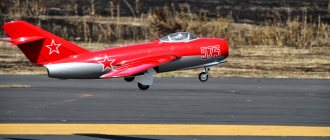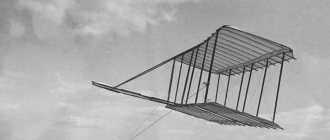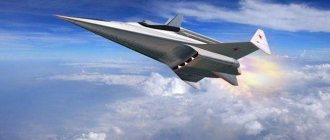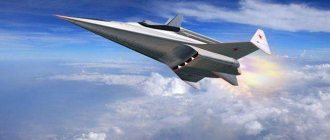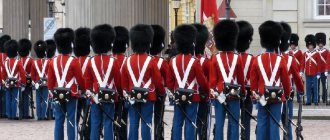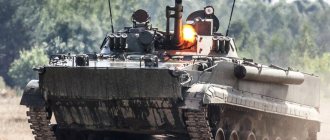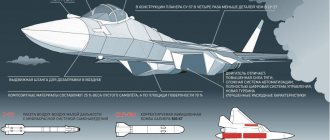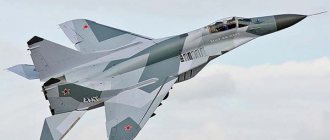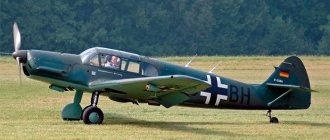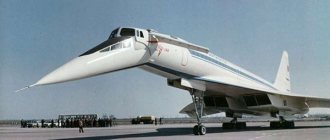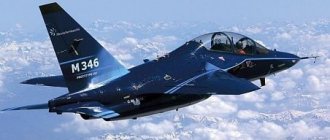In March 1947, a meeting was held in the Kremlin, at which Stalin set the task for fighter design bureaus to create a new fighter with the following characteristics: maximum speed of more than 1000 km/h, flight duration of at least one hour, ceiling 14,000 m. The aircraft was to be equipped with a cannon weapons with calibers from 23 to 45 mm. The next day, a resolution of the Council of Ministers No. 493-192 was issued, which formulated the task for designing a new fighter. In addition to the Mikoyan Design Bureau, similar assignments were issued to the Lavochkin, Yakovlev and Sukhoi design bureaus. On April 30, 1947, Air Force Commander-in-Chief Air Marshal K.A. Vershinin approved the tactical and technical requirements for the new front-line fighter, which basically repeated the words of Stalin.
Yakovlev was the first to complete the task. Already in August 1947, the aircraft, designated Yak-23, was ready, and on September 12 its testing ended. Having been the first to report to Stalin about the completion of the task, Yakovlev was unable to please the leader with the characteristics of the aircraft. The requirements were not met. The maximum speed did not exceed 940 km/h, and the flight range was 900 km. And yet the plane was put into mass production. It was in service both in the USSR and in a number of Warsaw Pact countries. The Sukhoi Design Bureau did not meet the deadlines allotted by Stalin, and was subsequently disbanded.
MiG-15 in the air
Luck was with Lavochkin and Mikoyan. The aircraft they created had approximately equal characteristics and were recommended for mass production. But Lavochkin’s fighter, which received the serial designation La-15, was withdrawn from service by 1955, the reason for this was difficulties in production (low technology) and complaints from combat pilots about difficulties in controlling the aircraft during takeoff and landing (the narrow track of the aircraft’s landing gear required the pilot to great attention and high precision piloting).
The Mikoyan Design Bureau began designing a new aircraft even before the competition was announced - in January 1947. The responsibility with which Mikoyan and Gurevich approached the task is evidenced by the fact that they considered several possible designs for a new fighter, among them: a fighter with two engines installed in the wing, a fighter with an engine according to a given design, like the MiG-9 , and even a double-boom aircraft like the English DH.113 Vampire. But they settled on the most optimal design, which became a classic for fighters around the world for decades. A spindle-shaped fuselage of round cross-section with a central air intake, a wing with a sweep of about 35°, a swept tail and a teardrop-shaped canopy.
For installation on the fighter, they chose the Nene jet engine, which made it possible to ensure the specified high flight characteristics. The design bureau took a risk, since the Nene I and Nene II engines were conventionally classified as bomber engines, and lighter, although less powerful, Derwent 5 engines were supposed to be installed on fighters.
Management of the design and development work on the creation of the MiG-15 was entrusted to Deputy Chief Designer A.G. Brunov and engineer A.A. Andreeva. Solving the problems of swept wing aerodynamics was entrusted to TsAGI specialists A.S. Khristianovich, G.P. Svishchev, Ya.M. Serebriysky, V.V. Struminsky and others. Their great merit is that the car “turned out” right away, and this is an extremely rare case for a new aerodynamic configuration.
When creating a high-speed fighter, the issue arose of providing the pilot with reliable means of rescue, allowing him, if necessary, to safely leave the aircraft. This complex problem was solved by a small group of engineers including test engineer E.F. Schwarzburg, candidate of technical sciences and master of parachuting V.A. Stasevich, doctors G.L. Komendangov, V.V. Levashov and P.K. Isakov. The group of rescue equipment was headed by Sergei Nikolaevich Lyushin.
Aircraft assembly at the plant named after. Stalin
When designing the aircraft, due attention was paid to operational manufacturability. The operational connector of the fuselage, dividing it into the nose and tail sections, is designed in the form of an easily detachable connection, ensuring convenient installation and dismantling of the engine. This fuselage division was subsequently used on all design bureau aircraft, up to and including the MiG-27.
The experience gained in solving problems related to the placement of artillery weapons that the OKB encountered during testing of the MiG-9 was not in vain. On the MiG-15, the placement of weapons was chosen so rationally that it made it possible not only to minimize the impact of powder gases on engine operation, but also to significantly simplify maintenance. The ease of operation of the weapons was achieved thanks to good approaches to the guns and their units, placed on a special carriage, which was part of the power circuit of the forward fuselage and, if necessary, could be lowered using built-in winches. Removing and installing all the guns, including opening and closing the hoods, raising and lowering the carriage, took only 15-20 minutes with the work of two people.
The first copy of the MiG-15 (designation KB S-01) was handed over for flight testing on December 19, 1947. Weather conditions did not allow the aircraft to take off for a long time, and only on December 30, the last day of the deadline set by Stalin, test pilot V. N. Yuganov made the first flight on the new fighter.
Factory tests continued until May 25, 1948. 38 flights were performed on the first copy and 13 on the second (S-02). But even before their completion, by resolution of the Council of Ministers No. 790-255 of March 15, 1948, the fighter was put into mass production under the designation MiG-15 with the RD-45 engine.
After the completion of the factory testing stage, both prototypes were transferred to state tests at the Air Force Research Institute.
During state tests, which took place from May 27 to August 28, 1948, the MiG-15 aircraft received a good rating from pilots and engineers. It was noted that this is the best fighter ever tested at the Air Force Research Institute. The test pilots indicated that the MiG-15 is not particularly difficult in terms of piloting technique and can be easily mastered by the flight personnel of combat units. Ground maintenance of the MiG-15 did not present any difficulties for the technical staff, who had already mastered the operation of jet aircraft. The shortcomings that needed to be eliminated included the lack of brake flaps, insufficient efficiency of the ailerons and a number of others that were supposed to be eliminated even before the aircraft was put into production. In general, the MiG-15 aircraft passed tests with a satisfactory rating.
On August 23, 1948, Resolution No. 3210-1303 of the Council of Ministers of the USSR was issued on the adoption of the MiG-15 for service and its launch into mass production at three factories at once. At the same time, the design bureau was required to eliminate the “childhood diseases” of the fighter and submit an improved vehicle for testing by July 1, 1949.
The first production MiG-15s were transferred for military testing to the 29th GvIAP at the Kubinka airbase near Moscow, which took place from May 20 to September 15. Combat pilots highly appreciated the new aircraft. It was noted that: “The MiG-15 aircraft is one of the best modern jet fighters in its flight and combat qualities.” The aircraft also received positive feedback from the engineering and technical staff. The report stated: “Ground operation of the MiG-15 aircraft with the RD-45F engine is simpler than the operation of the Yak-17 jet aircraft and La-9 and Yak-9 piston aircraft.”
However, it was recommended to make some changes to the design of the aircraft. In particular, install an engine starting system in the air, install an autonomous engine starting system on the ground, modify the fuel system and modify the emergency escape system, ensuring that during ejection the pilot is automatically separated from the seat and the parachute opens. All this was accomplished in the shortest possible time. After these modifications, the MiG-15 became a full-fledged jet fighter of the Soviet Air Force and the air forces of friendly countries.
History of creation
The development of a jet fighter of a fundamentally new design began at the Mikoyan Design Bureau as part of the aircraft construction plan for the new year 1947. At the same time, the document provided for the complete curtailment of work on piston machines, as having no prospects for development.
The terms of reference provided for the following parameters of the machine, which received the designation I-310:
- Use of a Rolls-Royce Nin turbojet engine or its domestic equivalent;
- The speed of the fighter at the surface of the earth is at least 1000 km/h;
- The maximum speed at an altitude of 5000 m is not lower than 1020 km/h;
- The time to reach an altitude of 5000 m is no more than 3.2 minutes;
- The length of the runway is no more than 800 m;
- Maximum flight altitude – not less than 13000 m;
- Flight range - about 1200 km at altitudes not lower than 10,000 m;
- The fighter was supposed to be armed with one 45 mm air cannon and two faster-firing 23 mm ones. External points were provided for hanging small aerial bombs with a total weight of up to 200 kg or an additional tank for kerosene.
The development of drawings for the new MiG design bureau and their implementation in metal took a little over a year. A prototype of the vehicle was assembled by early December 1947. The first flight took place on New Year's Eve - December 30.
The car was piloted by pilot V.N. Yuganov.
A few months later, the second prototype of the fighter flew, flown by S.N. Anokhin. Test tests of the vehicle were carried out at an accelerated pace and, according to good tradition, even before their completion, the vehicle was accepted into service by the USSR Air Force under the designation MiG-15. This happened in mid-March 1948, and the tests themselves continued until the end of May of the same year.
State tests of the future legendary MiG-15 aircraft took place in the summer, and the characteristics of the aircraft, albeit slightly, exceeded the requirements described in the technical specifications.
The maximum speed of the MiG-15 aircraft, based on the results of several runs, ranged from 1028 to 1042 km/h at altitudes of 5 and 2.62 km, respectively. At the same time, test pilots noted the simple and predictable control of the aircraft, accessible to average pilots.
But shortcomings were also noted, which were supposed to be improved on a control copy intended for additional testing.
The third prototype MiG-15 received brake flaps on the sides of the fuselage, an automatic fire extinguishing system in the engine compartment, the introduction of weight compensators on the rudder for height changes and the wing geometry was slightly changed.
It was this model that became the standard for serial production of the MiG-15 fighter with the RD-25F turbojet engine, which began to be delivered to military units in the spring of 1949.
At this time, a more powerful and advanced engine of the VK-1 model, which was based on RD-25F units and had almost identical weight and dimensions, passed acceptance tests. But by optimizing fuel combustion processes, engine thrust increased by 20% over a wide range of altitudes.
The first prototype of the MiG-15 fighter with this engine was ready by the fall of 1949. The main changes affected the rear part of the fuselage, since the VK-1 had a larger length and diameter of the nozzle extension pipe. To reduce the load on the controls, a hydraulic booster was introduced and the profiles of the elevators and rudder were changed.
The large dimensions of the engine required changing the shape of one of the fuselage tanks, due to which the fuel supply was reduced by 60 liters. New hatches for servicing units appeared on the outer part of the fighter fuselage.
If the MiG-15 with RD-25F had an artillery system consisting of NS-37 and NS-23 guns, then the modernized version was equipped with more advanced N-37D and NR-23KM guns. At the same time, the new guns were located closer to the axis of the aircraft, which increased the accuracy of fire.
Fighter design
Structurally, the MiG-15 aircraft was a mid-wing monoplane with a large sweep angle. The horizontal planes of the tail had almost the same angle of inclination and were located closer to the top of the vertical stabilizer.
This decision was dictated by the desire to remove the elevators from the flow disturbed by the wings. Because of this design feature, the MiG-15 aircraft had a rudder divided into two sections. The steering parts were controlled synchronously.
The planes of ailerons (with additional trimmers) and flaps were installed on the trailing edge of the fighter's wings.
The flaps had fixed positions in their design, which were used in takeoff and landing modes.
At the front of the MiG-15 fuselage there was an air intake, divided into two symmetrical channels by a sealed cockpit and a main rubber fuel tank located behind the cockpit.
In addition to the main tank, which held 1250 liters, there was an additional tank of 160 liters, located closer to the tail of the aircraft. A separate electrically driven pump was used to pump this volume into the main tank.
To control the fuel supply on the MiG-15 there was a sensor installed in the main tank. The emergency balance was a fuel supply of less than 300 liters. To maintain the weight distribution of the MiG-15 aircraft, fuel was produced from the tanks according to a special scheme.
Behind the transverse partition, a turbojet engine of the RD-25F model was installed, which on the MiG-15 bis was replaced by the VK-1, which had greater thrust parameters.
For maintenance and replacement of the engine, there was a connector through which the tail section could be separated from the main part of the fuselage.
The engine had an emergency fire extinguishing system with manual activation using a button on the instrument panel. When a fire occurs, foam is supplied from two cylinders directly into the combustion chamber and onto the outer part of the turbojet engine.
Under the lower part of the fuselage of a semi-monocoque fighter, a little further than the entrances to the air intake, a quick-release carriage frame with a 37 mm cannon and a pair of 23 mm was installed. On the ground, the carriage extended from the fuselage, and changing the ammunition took no more than 20 minutes.
To control the firing results, there was an S-13 photo-machine gun mounted on the first frame of the MiG-15 fuselage power frame.
The wing of the MiG-15 aircraft was built using a single-spar design. To strengthen the structure, there is one transverse beam, which plays the role of the wall of the main landing gear niche. The wings could be removed along the parting line with the fuselage, while load-bearing elements passed through it, with which the spar and plane beam were connected on each side.
The MiG-15 pilot's cabin with a large glass area and thin frame elements was equipped with a forced supply of fresh air and an ejection seat. To prevent fogging, the glazing was made of two layers of plexiglass with a thickness of 4 to 8 mm.
In the air gap there were silica gel granules, which were periodically replaced with fresh ones. In the frontal part of the fighter's cockpit there was armored glass with a thickness of 64 mm, fixed in an aluminum frame.
When closing the canopy, the joint was sealed with a special rubber seal with pumping from a pneumatic system.
The instrument panel also contained instruments for controlling the aircraft during flight, as well as navigation aids and a control panel for the aircraft landing system. The radio system of the MiG-15 fighter included a short-wave radio station and an automatic friend-or-foe identification device.
The 36-volt electrical system was powered by an on-board generator and battery. Additionally, on the side of the fuselage there was a connector for supplying power from a ground source.
To protect the pilot from bullets, an armor plate 10 mm thick was mounted on the front of the cockpit. This plate was fixed on the fourth frame, which served as the basis for the nose landing gear.
A hydraulic system was used to control all landing gear and additional brake flaps of the MiG-15 fighter, installed on the sides of the fuselage in the rear section. In this case, a pneumatic drive was used to brake the aircraft wheels.
The hydraulic drive was carried out from a pump installed on the drive box of the turbojet engine mechanisms. The working pressure of the liquid based on a mixture of glycerin and alcohol was at least 13.5 atmospheres.
The pneumatic drives of the MiG-15 were powered by several compressed air cylinders. The tanks were filled at the airfield; there was no on-board compressor for pumping.
Swept wing: “cut with an angle, but not bread, but air!”
After the war, the first gas turbine engines were developed, which allowed aircraft to accelerate to previously unknown speeds. But it soon became clear that this speed advantage required a quick solution to emerging problems - it was necessary to reduce aerodynamic drag. A way out of the situation could be wings with a sweep angle of more than 30 degrees.
Before the advent of real swept wings, jet aircraft with an aerodynamic airframe called “tailless” made it possible to evaluate their controllability and stability at high speeds. The most famous such project in the post-war years was the English experimental jet aircraft DH 108, which was called Swallow. However, in September 1946, the Lastochka crashed, which was a big blow to the very idea of \u200b\u200busing swept wings. The short flight of the “swallow” partly undermined faith in jet aviation - the opinion was expressed that at high speeds the plane inevitably collides with such a dense air environment that the wing cannot withstand it and is destroyed.
The design engineers understood that new ideas on aerodynamics and correct strength calculations were required. Artem Mikoyan, in order to convey his idea, found a simple and understandable image. Moving his hand from top to bottom, first vertically, then at an angle, he asked: “What is the easiest way to cut bread?” Having heard the natural answer that it’s easier with an angle, he said: “Let’s put a swept wing and we’ll cut with an angle, but not bread, but air!”
In this new development, Mikoyan closely interacted with a group of TsAGI researchers who studied swept wings under the leadership of Vladimir Vasilyevich Struminsky. Collaboration with scientists contributed greatly to the success of the MiG-15 - the machine turned out right away, which is a very rare case for a new aerodynamic configuration. Thus, the design solutions developed at the Mikoyan Design Bureau turned the swept wing into a working structure.
Various designs and configurations
In the documentation for early aircraft, there is a version of the MiG-15S fighter, which is a machine with a turbojet engine of the RD-45F model, two NR-23 cannons and a number of changes in the cockpit equipment and airframe. Such machines were not mass-produced.
For the version with drop tanks, the designation MiG-15PB was reserved, but since all production aircraft had suspension points, it was abandoned.
Based on the first MiG-15 aircraft, several prototypes were built, on which various weapons and equipment options were tested.
The third production aircraft, designated "SV", was used to test the modernized cannon armament, which included the NR-23 and N-37D cannons.
In addition to this, changes also affected the design of the vehicle - a trimmer appeared on the plane of the left aileron, anti-flutter weights on the wings, and improved electrical equipment and a sight. During the tests, numerous problems were revealed with the installation of new 23 mm caliber aircraft cannons, which were solved only on the MiG-15 bis fighter.
Some of the experimental solutions tested on the SF were subsequently implemented on modernized fighters.
Around this time, the “SO” version with an experimental retractable sight was tested. The design did not show any advantages and was not developed in the series. In the summer of 1950, several MiG-15 “SS” and “SU” fighters with 23 mm guns of the Sh-3-23 model were tested. They were not accepted as the main armament of Mikoyan's fighters.
Increasing production volumes of the new MiG-15 fighter entailed the need to train a large number of pilots. For this purpose, the MiG-15UTI training aircraft (NATO designation Midget) was created on the basis of a production machine.
The car had a two-seater cabin and developed lower speeds than a serial fighter. To practice air combat skills, the aircraft had one 12.7 mm UBK-E model machine gun with 150 rounds of ammunition and an NR-23 cannon with 80 rounds. On the lower part of the planes there were two suspension points for bombs of 50 and 100 kg caliber.
The MiG-15P UTI, equipped with a radar model RP-1, was produced in a small series.
The instructor's cabin was located at the rear and was obtained by reducing the size of the fuel tank. Both seats could be separated from the MiG-15 UTI aircraft using catapults. The glazed lantern was fired with a special squib.
Based on the modernized MiG-15 bis fighter, there was a reconnaissance version of the SR, armed with only one NR-23 cannon. Instead of the rest, photography equipment was installed.
The increase in flight range was achieved by an additional fuel supply of 1200 liters, located in two outboard tanks. The SD-UPB escort fighter, which was produced in 1951 in a single batch of 49 vehicles, could be equipped with the same tanks.
Decommissioned aircraft were often converted into radio-controlled targets, and were designated MiG-15M according to documents.
In addition to serial modifications, there were many experimental vehicles on which various versions of cannon and missile weapons, as well as radar stations, were tested.
On the basis of the MiG-15 bis aircraft, the experimental MiG-17 “SI” was created, which became the founder of a new family of fighters.
Catapult: a cannon that shoots a person
Opening up the possibilities of high speeds, the chief designer had to think doubly about the safety of the pilots. Artem Mikoyan immediately identified the vital need to develop a new ejection seat. By the way, the MiG-15 became the first fighter to be equipped with a special ejection seat as standard.
At high speed in an emergency, leaving the plane quickly and safely is not an easy task. Among other difficulties, there is a risk of being pinned by the incoming air flow. The powder charge of such a “catapult gun” should throw a person over the keel of the aircraft without dangerous overloads.
When creating an ejection seat for the MiG-15, a number of complex experiments were carried out. To calculate the ejection force, a special structure was built. A cart moved along a long rail track, almost vertical. At first it was rapidly accelerated by the firing mechanism, and then just as quickly stopped with the help of a powerful brake. At first, animals were “rolled” on a cart in this way, changing the charge strength each time. The first person who dared to “eject” in this way was the master of parachuting Rostislav Andreevich Stasevich (later the head of the department for ejection installations at the Yakovlev Design Bureau).
Then there were experiments on an airplane - they decided to shoot the seat from a Pe-2 bomber. The first, according to tradition, was “Ivan Ivanovich”, this is the name of the dummy, the weight and dimensions of which correspond to the data of the “average pilot”. Following him, parachute virtuoso Gavriil Afanasyevich Kondrashov ejected. Kondrashov’s bailout and his extremely clear report made it possible to sum up the development – further progress is possible.
Specifications
| Parameter | MiG-15 | MiG-15 bis |
| Fuselage length, m | 10,10 | 10,11 |
| Main wing span, m | 10,08 | 10,08 |
| Height, m | 3,7 | 3,7 |
| Wing area, sq. m | 20,6 | 20,6 |
| Power point | RD-45F | VK-1 |
| Thrust, kgf | 2270 | 2700 |
| Fuel capacity inside the fuselage, l | 1210 | 1400 |
The 37 and 23 mm caliber guns used on the fighters had the same ammunition load, consisting of 40 large-caliber shells and 160 small-caliber shells (80 per barrel).
Flight characteristics
| Parameter | MiG-15 | MiG-15 bis | Mig-15 UTI |
| Ground speed, km/h | 1042 | 1076 | 1010 |
| Speed at altitude limit 5000 m, km/h | 1021 | 1045 | 1004 |
| Speed at the altitude limit of 10000 m, km/h | 974 | 987 | — |
| Take-off speed, km/h | 230 | 227 | — |
| Approach speed, km/h | 174 | 170 | — |
| Ceiling, m | 15100 | 15500 | 14150 |
In addition to the USSR, the MiG-15 fighter was produced under license at aircraft factories in Poland, Czechoslovakia, and China. Polish cars were equipped with licensed engines and were designated Lim-1 or Lim-2 (similar to the Soviet 15 and 15 bis).
At their base, training vehicles and photo reconnaissance aircraft were produced. The total production of vehicles did not exceed 1000 copies, which entered service only with the national air force.
Czechoslovak fighters S-102 and S-103 were produced in large volumes and were actively exported. The main Czech-made machine was the training version CS-102, which was produced in more than 2000 copies. It was also actively exported to many countries.
Interestingly, later vehicles produced in Czechoslovakia had the Soviet designation MiG-15.
The main manufacturer of the aircraft is the USSR, which produced at least 11 thousand copies of the aircraft. According to other reporting data, the number of produced MiG-15 fighters of all types is more than 13.1 thousand aircraft. The aircraft was actively supplied to the armed forces of various states, including capitalist ones.
b YNMZHE 1946 C. B YuMTSKKHCH, ASHBSCH RNTSDU KKHDEPNL LHPNBNTsN PEYUYRKHBMNTsN DBKHTSUREKEYARPNEMKH, KH YANBERYAYNTSN YANCHGYU ASHKYU MYUPYUBKEMYU DEKETSYUZHKH, B YANYARYUB YNR NPNI BUNDHKH tsKYUBMSHE YNMYARPSYRNPSH: YAYULNKERVKHY yu.h.lKHYNYM, DBKHTSUREKHYAR b.yKHLNB KH BEDSYKHI YAOEZHHYUKHYAR ON YUBKHYUZHNMMNLS LYUREPHYUKNBEDEMHCH I. r.yHYHM. YANBERYAYNI DEKETSYUZHKH SDIUKNYAE GYYSOKHRE MUKHANKEE YANBEPEEMMSHE RSPANPEYURKHBMSHE DBKHTSUREKH THPLSH pNKKYA-PNIA: “DEPBEMR-V” I RTsNI 1590 YTSYA, “mKhM-I” I RCNI 204 0 YTSYA X "mХМ-II" I РЪЦНИ 2270 YTSYA. SFE B TEBPYUKE 1947 Ts. .b DUKEMEYEL MNBKHMYKH YUMTSKKHIYYYNTSN DBKHTTSUREKEYARPNEMKH ASHKKH SYAOEMN YAYNOKHPNBYUMSH X GYUOSYEMSH B YAEPKHIMNE OPNKHGBNDYARBN. “DEPBEMR-V” BSHOSYAYUKYA NREVEYARBEMMNI OPNLSHKEMMNYARECH OND MYUGBYUMHEL pd-500, Yu “mKhM-I” X “mKhM-II”, YANNRBERYARBEMMN, OPEBPYURKHKHYAE B pd-45 X pd-45t. th ONDTSNRNBYE YEPKHIMNTSN OPNKHGBNDYARBU MU GYUBNDYUU No.45 (DBHTSYUREKE pd-45) X No.500 (pd-500) OPHYARSOKHKH I LYU 1947 Ts. YUBNDYU No.45 MU YAMERKHE VEPREFEY, YUMYUKHG LUREPHYUKNB, YU RUYFE MU DKHREKEMSHE HYAOSHRYUMKH ASKN KHGPYUYAUNDNBUMN EYARE "mKHMNB", B RNL VHYAKE DBYU "mKhM-II".
ONEBKEMKHE MNBSHU DBKHTSUREKEY ONGBNKKHKN YANBERYAYNLS YANCHGS OPKHYARSOKHRE Y YANGDYUMKHCH PEYURKHBMSHU HYARPEAHREKEY MNBNTSN ONYNKEMKH. SFE 11 LYUPRYU 1947 Ts. YANBER lHMKHYARPNB yayap YABNHL oNYARYUMNBKEMHEL No.493-192 SRBEPDHK OKYUM NOSHRMNTsN YAYULNKERNYARPNEMKH MU 1947 TsND. MU NYAMNBYUMHH SRBEPFDEMMNTSN OKYUMYU, 15 YOOPEK OPKHYUGNL luo No.210 YNKKEIRKHBS, BNGTSKYUBKELNLS y.h.lHYNJMNL (nya-155, GYUBND No.155), ASHKN SRBEPFDEMN GYUDYUMKHE MU PUGPYUANRYS TPNMRNBNTSN HYARPEAHREK I TSEPLERKHVEYAYNI YUAHMNI, YNRNPSHI RPEANBUKNYAE ONYARPNHRE B DBSU SHYGELOKPYUU H OPEDZBKHRE MY TSNYASDYUPYARBEMMSHE HYAOSHRYUMKH B DEYUAPE. TYURKHVEYAYKH, PUANRS MYUD MNBNI LYUKHMNI B NYA-155 MYUVYUKH EYE B OMBUPE 1947 Ts.
pYUGPYUAYURSHBUELSHI HYARPEAHREKE, ONKSVKHBKHI MUHLEMNBUMHE x-310
X GYUBNDYAYNI bHTP “I”, DNAFEM ASHK HLERE BEYAEL BSHYANYKHE KERMSHE UYUPYUREPHYARKHYH: LYUYAHLYUKEMSC YAYNPNYARE 1000 YL/V S GELKH X 1020 YL/V MU BSHIANRE 5000 L. bPEL ONDZ ELYU MU BSHYANRS 5000 L - 3.2 LHM, OPYURKHVEYAYKHI ONRNNKNY 13000 L X DUKEMNYARE 1200 YL OPH ONKERE MU BSHIANRE 10000 L I MUKHBSHTSNMEIEI YAYNPNYARECH. PYUGAETS DNAFEM ASHK YANYARYUBKЪRE 700 L, YU OPNAETS 800 L. eTsN BNNPSFEMHE DNAFMN ASHKN YANYARNЪRE HG RPEU AXIS: NDMNI 45-LL X DBSU 23-LL. yPNLE SCHRNTSN, BLEYARN ONDBEYAMSHU RNOKHBMSHU AYUNB OPEDSYALYURPHBYUKYUYAE BNGLNFMNYARE PYUGLEYEMH ANLANBNNI MYUTSPSGYH B 200 YTS. Mu Mnbny Lyuhme Okumhpnbuknya Seyumnbhre ENDHM Hugammamsha Puyuyrchbmsha dBkhsyurei "MHM", YNRNPSHE ONGBKEKKEEAOVKRE GUDYUMSHAMSHA Uyupyupyarchyh. bYaETsN HG 25 ONKSVEMMSHU "mKHMNB" 16 ASHKN OEPEDYUMN PYUGKHVMSHL nya, B RNL VHYAKE RPH - nya-155.
30 YOOPEK 1947 Ts. .
sYARYUMNBKEMMSHI YAPNY YADYUVKH HYARPEAHREK MY TSNYAHYAOSHRYUMKH BSHDEPFYURE ME SDUKNYAE, RYU YUY B REVEMHE BYAETSN 1947 Ts. ON DNPYUANRYE YYULNKERYU lHts-9, KH NYNAEMMN, ETSN BNNPSFEMH. b YABGKH I SHHRHL, OEPBSHI NOSHRMSHY SHYGELOKP x-310 (ya-1) ASHK BSHOSYEM MU KERMSHE HYAOSHRYUMKH RNKEIN 19 DAYUAP. ONYAKE OPNBEDEMKH MUGELMNI NRPYUANRYKH 30 DAYUAP 1947 Ts. YAYULNKER, OKHKNRKHPSELSHI KERVKHYNL-HYAOSHRYUREKEL b.m.chTSYUMNBSHL, YANBEPHK OEPBSHI ONKER. bRNPNNI NOSHRMSHY SHYGELOKP x-310 (ya-2) Y YNMZHS TsNDYU MUUNDHKYA B YANYARNMHKH 57% TsNRNBMNYARKH.
y YNMZHS LYUPRY 1948 Ts. MU i-1 OH OPNTsPYULLE GYUBNDYAYHU HYAOSHRYUMKHI ASHKN BSHONKMEMN 17 ONKERNB, YU B NOSHRMNL OPNKHGBNDYARBE GYUBEPHKH YANPIS i-2. KERVKHYNL-HYAOSHRYUREKEL MU BRNPSCH LYUHMS MYUGMYUVHKH y.m.yuMNUHMYU, YNRNPSHI 5 YOOPEK 1948 Ts. BSHONKMKHK MU MEI OEPBSHI ONKER.
sFE MU OEPBNL SCHRYUOE GYUBNDYAYKHU HYAOSHRYUMKHI, OPNDNKFYUBHUYA DN 25 LYU 1948 Ts., HYARPEAHREKE x-310 (i-1) ONYUGYUK UNPNNKHE PEGSKERYURSH. b YABGKH I SCHRHL, ONYARYUMNBKEMHEL YANBERYU lHMKHYARPNB No.790-255 NR 15 LYUPRY 1948 Ts. LYUKHMYU OND NANGMYUVEMHEL lHts-15
I DBKHTSUREKEL pd-45 ASHKYU GYUOSYEMYU B YAEPKHIMNE OPNKHGBNDYARBN MU GYUBNDE No.1 HL.yaRYUKHMYU. schRHL FE ONYARYUMNBKEMHEL SYARYUMYUBKHBUKYA MNBSHI JAPNY YADYUVH YAYULNKERYU MU TSNYASDYUPYARBEMMSHE HYAOSHRYUMKH - 10 LYU.
ON GYUBEPYEMKHCH GYUBNDAYKHU KERMSHU HYAOSHRYUMKHI, BN BPEL YNRNPSHU MU I-1 ASHKN BSHONKMEMN 38 ONKERNB X 13 ONKERNB MU I-2, YAYULNKERSH ASHKKH OPEDZBKEMSH B tsy mkhx bbya MY TSNYAKH YAOSHRYUMKH. b YUVEYARBE NYAMNBMNTSN, BNEMMSHL 27 Lyu 1948 Ts. MYUK XG khkh luo B vYYUKNBIAYSCH. yu 5 KhChK ASHK OPHMR OEPBSHI SHYGELOKP lHts-15 (i-1) DK OPNBEDEMH KHYAOSHRYUMKHI BNNPSFEMKH YAKHYARELSH YUBYUPKHIMNTSN YAPNYAYU TNMYUP. ShchRS LYUHMS ONYAKE GYUBEPYEMKH MU MEI DNONKMHREKEMSHU HYAOSHRYUMKHI MU URNONP H NOPEDEKEMH YAYNPNYARKH ON BSHIANRYUL OEPETSMYUK B tsy mkhh bbya BEVEPNL 22 KhChM KERVKHY-HYAOSHR YUREKE h.r.xBYUYEMIN.
bN BPEL TSNYASDYUPYARBEMMSHU HYAOSHRYUMKHI, OPNUNDHBKHU B OEPKHND I 27 LYU ON 25 YUBTSSYARYU 1948 Ts., YAYULNKER lHts-15 ONKSVHK BSHIANYSCH NZHEMYS. ON YABNEI LYUYAKHLYUKEMNI YAYNPNYARKH, YAYNPNONDZELMNYARKH, ONRNKYS KH DUKEMNYARKH ONKERYU NM ASHK KSVIKHL HG HYAOSHRYUMMSHU B tsy mhh bbya NREVEYARBEMMSHU HYARPEAHREKEY. oPHVEL, NYAMNBMSHE KERMSHE UYUPYUREPHYARKHYH, ONKSVEMMSHE B OPNZHEYAYAYE HYAOSHRYUMKHI, ME RNKEIN SDNBCERBNPKKH RUYRKHYN-REUMHVEYAYHL RPEANBYUMKHL, MN X OPEBGNYKH KH. MU BSHYANRE 5000 L YAYNPNYARE YAYULNKERYU YANYARYUBHKYU 1028 YL/V, YU MU BSHYANRE 2620 L - 1042 YL/V.
MUANP BSHYANRSH 5000 L NYASYYYARBKKYA GYU 2.3 LHM, BLEYARN RPEASELSHU 3.2 LHM. gMYUVEMHYUYAHLYUKEMNI DUKEMNYARKH ONKERYU MU BSHIANRE 10000 L ASHKN OPEBSHYEMN MU 195 YL, YU OPYURKHVEYAYNTSN ONRNKYU - MU 2200 L. PYUGAETS X OPNAETS RUYFE ASHKH LEMEYE RPE ASELSHU, X YANYARYUBHKH 600 X 765 L YANNRBERYARBEMMN.
on LMEMKHCH BEDSYKH KERVKHYNB-HYAOSHRYUREKEY ch.yu.yuMRKHONBU X h.l.dGCHASH, YU RUYFE KERVKHYNB NAKERYU o.l.YARETYUMNBAYNTSN, y.ts.yNVEREINBYU H y.ts.opNYUYNBU, ON REUMHY E OHKNRKHPNBUMHЪ lHts-15 NYANANI YAKNFMNYARKH ME OPEDYARYUBKK . OPH SYAKNBKHH DNBNDYKH ETSN OH SOPYUBKELNYARKH, ANYNBNI SYARNIVKHBNYARKH, YULNPRKHGYUZHHH YUYAYAKH X SYARNIVKHBNYARKH MU OPNAETSE, LNTs ASHRE KETSIN NYABNEM KERMSHL YANYARYUBNL YAPEDMEI YBYUKHTHYUZHHH.
MUGELMNE NAYAKSFKHBYUMHE lHts-15 DK REUMKHVEYAYNTSN YANYARYUBYU, NYABNKHBIETSN SHYAOXYURYUZHCH PEYURKHBMSHU YYULNKERNB, RPSDMNYAREI ME OPEDYARYUBKKKN, KH ASHKN GMYUVHREKEMN OPNYE, VEL MUGELMNE NAYAKSFKHBYUMKHE YAYULNKERYU lHts-9 I DBSL PD-20. gYuOSYAY pd-45t MU GELKE ASHK NVEME OPNYAR, RYU YUY NYASYYYARBKKYA MUFYURKHEL RNKEIN MU NDMS YMNOYS, PUYAONKNFEMMSCH MU PSYNYRYE PSHVYUTSIU SOYUBKEMKH DBHTSUREKEL.
MYALNRP MU MEINRNPSHE BSHUBKEMMSHE MEDNYARYURIKH, B ZHEKNL KHYARPEAHREKE lHts-15 HYAOSHRYUMKH OPNYEK SDNBCERBNPHREKEMN H ASHK PAINLEMDNBYUM DK YAEPKHIMNTSN OPNKHGBNDYAR BYU. 23 YUBTSSYARYU, GYU RPKh DMJ DN NYNMVYUMKH TSNYASDYUPYARBEMMSHU HYAOSHRYUMKHI, YANBER lHMHYARPNB yayap BSHOSYARKHK ONYARYUMNBKEMKHE No.3210-1303 N OPKHMЪRKHH lHts-15 MU BNNPSF EMHE X GYUOSYAYE ETSN B LYuYANBNE OPNKHGBNDYARBN. OND ONYARPNIYS lHtsyu BSHDEKKNYAE RPH GYUBNDYU luo: No.1 HL. YARYUKKHMYU B YSIASHYEBE, No.153 HL.vYYUKNBU B mNBNYAHKHPAYE X No.381 B LNYAYBE. 29 YaEMRЪAP YANBLKHM OPKHMЪK ONYARYUMNBKEMKHE No.3655-14282, NAIGSHBUCHYEE TsKYUBMNTSN YNMYARPSYRNPYU lKHYNMYU SYARPYUMKHRE DETEYRSH, BSHBBKEMMSHE MY TSNYASDYUPYARBEM MSHU HYAOSHRYUMKHU, KH B MNYAPE 1948 Ts. OPEDZIBHRE DNPYUANRYUMMSHI lHts-15 MU YNMRPNKEMSHE HYAOSHRYUMKH B tsy mkhh bbya.
rPERKHI NOSHRMSHI SHYGELOKP KHYARPEAHREK lHts-15 (i-3) I BMEYAEMMSHLH SKSVIEMKHLH ASHK ONYARPNEM B LYUPRE 1948 Ts., Yu 20 KhChM YAYULNKER, OKKNRKHPSELSHI KERVKHYNL-KHAOSHRYUREK EL YUMNUKHMSHL, YANBEPHK OEPBSHI ONKER. dNPYUANRYH, OPNBEDEMMSHE MU I-3 B ZHEKU SKSVIEMKH SHYAOXYURYUZHNMMSHU H ANEBSHU YUVEYARB, ASHKH YABGYUMSH, B NYAMNBMNL, I SYARYUMNBYNI BNGDSMSHU RNPLNGMSHU YKHRYNB OKNYYUDECH 0.48 L2, PYUGLEYEMHEL B DBKHTSYUREKEMNL NRYAYE OPNRKHBNONFYUPMNTSN NANPSDNBYUMKH KH OPNBEDEMHEL PJDU DPSTSKHU SYANBEPEMYARBNBYUMKHI B YNMYARPSYZHKH X YAKHYARELYU HYARP EAHREK. b VYUYARMNYARH - ASHKKH DNPUANRYUMSH YHKE KH SCHKEPNMSH, BBEDEMYU BEYANBYU YNLOEMYUZHH PSKEY BSHYANRSH ON RHOS PSK ONBNPNRYU, YU DK SLEMEEMKH KHGKHMEI ONOEPEVMNI SYARNIVKHB NYARKH SBEKHVEM SCNK ONOEPEVMNTSN V YPSHKYU I -1╟ DN -2╟.
yNMRPNKEMSHE HYAOSHRYUMHYA I-3 OPNBNDHKHYAE B OEPKHND I 4 MNAP ON 3 DAYUAP 1948 Ts. KERBNPHREKEMN. KERMN-RUYRHVEYAYHE DYUMMSHE, ONKSVEMMSHE OPH HYAOSHRYUMKHU, YANNRBERYARBNBUKH RPEANBYUMKHIL Y OPKHMIRNLS MU BNNPSFEMKHE YAYULNKERS lHts-15, OPHVEL LYYYAHLYUKEMYU I YNPNYARE MU BSHIANRE 1600 L DNYARKHTSKYU 1047 YL/V. YaYULNKER I-3 ASHK PAINLEMDNBYUM B YUVEYARBE SCHRYUKNMYU DK YAEPKHIMNTSN OPNKHGBNDYARBU.
BEYAMNI 1949 Ts. OH 15 YAEMRP, B MKHU SVYUYARBNBUKN 20 YAYULNKERNB 4-I X 5-I YAEPKHI BSHOSYAYU GYUBNDYU No.1.
xU KERMN-REUMHVEYAYKHE UYUPYUREPHYARKHYYH OPYURHVEYAYH ME NRKHVYUKHYAE NR UYUPYUREPHYARKHY I-3, OPYUBDU, X OEPEVEME DETEIRNB ONVRH ONKMNYARECH YNOKHPNBYUK YANNRBERYARBSCH YKHI PUGDEK YURYU ON HYAOSHRYUMHYU NOSHRMNTSN lHtsyu. MYALNRP MU MEDNYARYURYKH, YARPNEBSHE KERVKHYKH BSHIANYN NZHEMHKH MNBSC LYUHMS: “YaYULNKER lHts-15 OH YABNHL KERMSHL H ANEBSHL YUVEYARBYUL ЪBKЪRYAЪ NDMHL HG KSVIKHU YANB PELEMMSHU PEYURHBMSHU HYARPEAHREKEY.” EYE ANKEYE ASHK DNBNKEM KHMFEMEPMN-REUMKHVEYAYKHI YANYARYUB: “mYUGELMYU SHCHYAOXYURYUZHKH YYULNKERYU lHts-15 I DBKHTSUREKEL PD-45T OPNYE, VELED SHYYAOXYURYUZHKH PEYURHBMNTSN YAYULNK ERYU yY-17 X ONPMEBSHU YAYULNKERNB kYu-9 X yY-9.” LEFDS REL, Bnya-155 OPNDNKFYUKH PUANRSH ON YANBEPEMYARBNBUMHCH HYARPEAHREK. lNDHTHYUZHHH :
| lHts-15l (i) | TPNMRNBNI HYARPEAHREKE |
| lHts-15l (yadl) | PUDHNSOPYUBKELSHI YAYULNKER-LHYEME. oEPENANPSDNBYUMKHCH B LKHYEME ONDBEPTSYUKHYAE YAMHLUBHYAHYA I BNNPSFEMHYYULNKERSH, YNRNPSHE EYE ME KHGPYYUNDNBUKH KERMSHI PEYASPA. dHYUOYUGNM BSHYANR ANEBNTSN OPHLEMEMKH lHts-15l YANYARYUBKHK 8000-13000 L, YU BPEL MUANPU LYYYAHLYUKEMNI BSHYANRSH I BSHBNDNL MU ANEBNI YSPYA 17-18 LHM. YAYNPNYARE B TsNPKHGNMRYUKEMNL ONKERE MU LYYYAHLYUKEMNI BSHYANRE 880-950 YL/V. nAYYU OPNDNKFHREKEMNYARE ONKERYU 55 LHM . |
| lHts-15r | ASYAHPNBIKHYH LHYEMEI. |
| Lim-1 | lHts-15, YARPNHBHIYYA ON KKHZHEMGKHH B ONKEYE. |
| Lim-1.5 | ONKEYAYU LNDEPMHGYUZHH Lim-1 I PUDHNMYUBHTSYUZHNMMSHL NANPSDNBYUMHEL ON RHOS lHts-15AHYA. |
| Lim-3 (Lim-1b) | srkh lHts-15, YARPNHBHIYYA ON KKHZHEMGKHH B ONKEYE. |
| SBLim-1 | srkh lHts-15, YARPNHBHIYYA ON KKHZHEMGKHH B ONKEYE. |
| SBLim-1yu | PUGBEDVKHY-YNPPEYRKHPPNBYKHY I SYAKHKEMMSHL BNNPSFEMHEL (2 AXIS MP-23 YUKHAPU 23 LL). |
| SBLim-2 | DNPUANRYU yaS-102 (srkh lHts-15, YARPNHBHIYYA ON KKHZHEMGKHH B VEUNYAKNBUYHH), X SBLim-1 OND DBKHTSUREKE bi-1yu (Lis-2A) HP Lim-2. |
| SBLim-2yu | PUGBEDVKHY-YNPPEYRKHPPNBYKHY I SYAKHKEMMSHL BNNPSFEMHEL (2 AXIS mp-23 YUKHAPIU 23 LL) X DBKHTSUREKEL bi-1yu (Lis-2A). |
| S-102 | lHts-15, YARPNHBHIYYA ON KKHZHEMGKHH B VEUNYAKNBUYHH MU GYUBNDE “Aero”. |
| CS-102 | srkh lHts-15, YARPNHBHIYYA ON KKHZHEMGHH B VEUNYAKNBUYHH. |
| J-2, JJ-2 | YHRYYYAYHE NANGMYUVEMHЪ lHts-15 X srkh lHts15. b yHRYUE YAYULNKERSH PELNMRKHPNBYUKHYAE, DNPUAYURSHBYUKHYAE X OPNDYUBYUKHYAE RPEREHL YARPUYUL OND NANGMYUVEMHYALEH F-2, FT-2. |
| cru: |
| lNDHTHYUZHH | lHts-15(C-3) |
| pYUGLUU YPSHKYU, L | 10,08 |
| dKKHMYU YAYULNKERYU, L | 10,10 |
| bSHYANRYU YAYULNKERYU, L | 3,17 |
| OKNYYUDE YPSHKYU, L2 | 20,60 |
| I love it, JC | |
| OSYARNTSN YYULNKERYU | 3149 |
| MNPLYUKEMYU BGKERMYU | 4806 |
| рНОХБН, K | 1450 |
| RHO DBKHTSUREK | 1 RPD PD-45t |
| LYUYAKHLYUKEMYU ROTSIU | 1 U 2270 |
| LYUYAKHLYUKEMYAYNPNYARE, YL/V: | |
| WITH GELKH | 1047 |
| MU BSHIANRE | 1031 |
| oPUYRHVEYAYU DUKEMNYARE, YL: | 1310 |
| LYUYAKHLYUKEMYYAINNONDZELMNYARE, L/LHM | 2520 |
| oPUYIRKHVEYAYKHI ONRNNKNY, L | 15200 |
| ShYKHOYUF, VEK | 1 |
| bNNPSPHEMHE: | NDMU 37-LL OSYU mya-37 X DBE 23-LL OSYYH mya-23 |
| bottom. KhMTNPLYUZHKH: |
| The Vepepen “Lhynm, TsSpubHV LHTS-15 (1)” Veperf “LHYNM, TsSpubHV LHTS-15 (2)” Vepepen “Lhyinm, TsSpubHV LHTS-15 (3)” Vepern “Lhyinm, TsPPEBHV LHTS-15 (4)” Yaryura “ lHts-15 MU AKKHFMEL BNYARNYE "YARYURE" "LHts-15 OPNRKhB "YEIAPYU" YYURE" "YUMYUKHG SVYUYARKH lHts-15 B YNPEIYAINL YNMTKHYRE" YARYURE "lHtsH B YNPEE" YAYURE "ve PMYU MEDEK ANLAYUPKHPPNBNVMNTSN YNLYUMDNBYUMH" YARYURE "YSAKHMYAYKHE lHtsKH. lHts-15" tNRNTsPYUTHH: | x-310 (lHts-15 (i-1)) |
| x-310 (lHts-15 (i-1)) | |
| x-310 (lHts-15 (i-1)) | |
| x-310 (lHts-15 (i-1)) | |
| lHts-15 (i-1) | |
| lHts-15 (i-2) | |
| lHts-15 (i-2) I OPNRKHBNRNONPMSHHLH PUYERYULH | |
| lHts-15 (i-3) | |
| lSGEIMSHY lHts-15 (i-3) | |
| oPKHANPMYU OYUMEKE lHts-15 (S-102) |
IWELSH:
| lHts-15 |
| bYUPHYUMRSH BMEMKHU ONDBEYANY |
bYUPHYUMRSH NYPYYAYH:
| x-310 (lHts-15 (i-1)) |
| lHts-15 B MYUVYUKE 50-U |
| YaOHYANY HYARNVMKHYNB: |
| yPSHKE PNAYAHH. hYARNPKH YYULNKERSHnya "lHts" yuPLUDYU. EBTSEMKHI YUPYAEMEEB, kENMHD yPSHKNB. HYARPEAHREKE lHts-15 yPSHKE pNDHMSH. EBTSEMKHI YUPYAEMEEB. “pBDNBNI” YUBHYUZHHH l-uNAAH. EBTSEMKHI YUPYAEMEEB. bRPHUKH Y ONPRPERS lHts-15 lHP YUBHYUZHHH. k.yPShKNB, ch.rEOYASPYUEB. YaYULNKER-YANKDYUR yPSHKE pNDHMSH. to. SCHEMASPTS. lHts-15. pNYARHYAKYUB bKhMNTsPYUDNB, UKEYYYUMDP oNMNLUPEB. pYUGBHRKHE YYULNKERNB LHPYU hYARNPKH YNMYARPSYZHHI YYULNKERNB B yayap 1951-1965TsTs. YaKHLYINB a.k. YaYULNKERSH YARPIUMSH YANBERNB. 1917-1970 Aerofax. Yefim Gordon. Mikoyan-Gurevich MiG-15 WarbirdTech. Yefim Gordon, Peter Davidson. Mikoyan Gurevich MiG-15 Fagot |
sTSNKNY MEAYU. 2010
Combat use of the aircraft
The MiG-15 serial fighter appeared at the peak of the tense situation in Southeast Asia, which resulted in a war between North and South Korea. During active hostilities, many samples of new Soviet and American weapons were tested in combat.
The American F-80s with a straight wing, used at the beginning of the war, had no chance in battles with MiGs.
Later, the main rival of the Soviet aircraft became the F-86 Saber fighter, which had a very similar layout.
At the same time, the aerobatic and speed characteristics of the vehicles were approximately the same. The difference was the Saber's better maneuverability at low altitudes, but the MiG-15 had a noticeably better climb rate and higher flight speed at medium and high altitudes.
The main difference between the vehicles was the armament, which consisted of three cannons on the Soviet vehicle and six heavy machine guns on the American. Only the latest Saber models, which appeared towards the end of the Korean War, received more powerful weapons of four 20-mm cannons.
A big plus was the presence of a radio range finder on the F-86, which made it possible to start fire from long distances.
A similar device appeared on the MiG-15 fighter only in 1952.
Since air combat tactics have not changed since World War II, the MiG-15 fighter was more suitable for active operations. Due to the high weight of the salvo and the damaging effect of the shells, the Soviet vehicle had a much higher chance of victory.
During the battle, American pilots sought to take the MiG-15 to low altitudes in order to compensate for weak firepower with high maneuverability.
After the end of the Korean War, MiG-15 vehicles took part in many armed conflicts, but were unable to prove themselves anywhere else. Among the conflicts involving these aircraft, it is worth noting the confrontation between China and Taiwan, the Sinai War and the Arab-Israeli wars of the 60s.
By the time the Vietnam War began, the MiG-15 was considered completely obsolete and was not used in combat. However, the machine was widely used to train pilots in piloting skills of new Soviet fighters.
Interesting Facts
MiG-15 fighters turned out to be the most effective aircraft in the Air Forces of the People's Republic of China and Korea. During its use in the Korean War, at least 1,377 victories were achieved with the loss of 566 aircraft.
Among the enemy aircraft shot down are at least 78 (the number of losses recognized by the United States) F-86 Saber fighters, which at that time was the most modern aircraft in the US Air Force. The most famous ace of the Korean War, Yevgeny Pepelyaev, flew various versions of the MiG-15 aircraft and scored 23 confirmed aerial victories.
The high flight performance of the MiG-15 fighter was the reason for the persistent desire of the Americans to get a flying copy of the fighter.
A reward of 100 thousand US dollars was announced for moving the car, which was a very significant amount in the 50s. But the first copy of the MiG-15 reached the Americans after the end of hostilities in Korea. After a series of tests, the vehicle ended up in the National Air Force Museum, where it remains today.
During the Korean War, MiG-15 fighters actively resisted American air raids using B-29 Superfortress strategic bombers.
In one of the air battles in the fall of 1950, MiG-15 fighters shot down at least 12 “superfortresses” and several escort vehicles. This battle, which went down in the history of the American Air Force as “Black Tuesday,” dramatically changed the tactics of using strategic bombers, which began to be used only at night.
An equally famous pilot of the MiG-15 aircraft was the first cosmonaut Yuri Gagarin, who served for two years in a combat aviation regiment in the Northern Fleet, armed with such machines. Yu. Gagarin died during another training flight on the MiG-15 UTI training aircraft.
Victory for three
And yet, the Saber was captured - this was done on October 6, 1951 by the commander of the 196th Fighter Aviation Regiment, Colonel Evgeny Pepelyaev (later Hero of the Soviet Union, the second most successful ace of the Korean War - he accounted for 19 shot down American aircraft). Here's what the pilot himself said:
“The battle turned out to be sharp. We were already leaving the fight, the plane was full of holes, and then literally in front of our noses was a Saber. I chased him. He made a sharp turn. I reach for it and, before the pilot senses danger, I open fire in an inverted position. Smoke began to rise from the place where the lamp was located, and the car began to fall. I didn’t pursue him, I realized he wouldn’t fly far. As it turned out, the engine and catapult were slightly damaged. The Saber pilot had no choice but to land the plane. We must give him credit, he did it masterfully. Gliding, I reached the Yellow Sea, or rather the West Korean Gulf, and sat down on the pebbles just at the moment when the tide began to ebb. The pilot left the plane, launched a rescue inflatable boat and swam out to the open sea to avoid being captured. Then we learned that he was soon picked up by the rescue service - the Americans operated it flawlessly. The SA-16 flying boat delivered it to its territory. But the fighter remained."
Let us note that the assistant commander of the 176th Guards Fighter Aviation Regiment for tactics, Major Konstantin Sheberstov, who was awarded the title of Hero of the Soviet Union on October 30, 1951, also claimed the captured F-86. He and his wingman, Captain Ivan Lazutin, stated at the debriefing that they were the ones who shot down the Saber plane that had landed on the seashore. As a result, the aerial victory was attributed to Major Sheberstov, although Evgeniy Pepelyaev did not agree with this until the end of his life. But this dispute does not change the essence.
© soviet-aces-1936-53.ru
And yet, the Saber was captured - this was done on October 6, 1951 by the commander of the 196th Fighter Aviation Regiment, Colonel Evgeny Pepelyaev.
So, the F-86 fighter (No. 49-1319), piloted by Captain Gill Garrett from the American 336th Squadron (FIS), made an emergency landing on a low tide strip on the shore of the West Korean Gulf, 13 kilometers west of the city of Pyeongwon. Further events, according to eyewitnesses, developed as follows. Two or three hours later, American bombers appeared and began to bombard the Saber landing area with bombs. However, the tide had already begun, and the foamy sea water reliably covered the plane.
Night has come. Soviet aviators were given the task of getting the fighter out of the water and delivering it to the Andong airfield. We didn't manage it overnight. Initially, they dragged it a decent distance from the shore into a field and disguised it as a haystack. He stood there all day. From the coast to the airfield there is a road with tunnels, you can’t transport a winged car. With the onset of darkness, the fighter’s wings were cut, and the very next morning the Saber stood among the MiGs. Each pilot considered it necessary to sit in his cockpit until the prisoner was packed piece by piece into boxes and sent to Moscow. All of the Saber's equipment—flight, navigation, electronic, and weapons—were in good condition. The adjustment and power supply unit of the altitude-compensating suit was also undamaged. Soviet pilots did not have this. So the trophy was valuable.
And a little later, another Saber fell into our hands thanks to the brilliant work of a pilot of the 16th Air Defense Fighter Regiment of the 97th Air Defense Fighter Division: after the battle, the American fighter made an emergency landing on territory controlled by North Korean troops, the pilot was captured . The F-86 was promptly delivered to Andong airfield. The Americans, as the first time, did not immediately come to terms with the loss of Saber.
Here are the memoirs of Abazar Gabdullin, at that time the commander of the anti-aircraft gun crew covering the airfield:
“I remember the story of the captured Saber well. When he was delivered to us, we, the anti-aircraft gunners, did not think that in a day or two he would have to do a lot of work near the guns. At first, we, like the pilots, took turns getting acquainted with the trophy. I couldn’t stand the temptation either; I approached the plane several times. It apparently belonged to an American ace. Below the cabin were 12 or 14 five-pointed stars. Our pilots then kept wondering: whose planes are on the Saber’s owner’s account—Soviet or Korean, fighters or bombers? And a day or two later, in my opinion, the Saber was already sent to Moscow, and this began... The Americans bombed the landing site of their newest fighter several times, and then they guessed - it was in Andun... They had made forays to the airfield before, but that’s all -they were still afraid of us. 37mm automatic anti-aircraft guns have the highest rate of fire. There was no empty space left in the firing zone, the probability of a hit was 100 percent. Here the American command went, as they say, all-in - the Saber had to be destroyed. The battle was hot, even gun barrels were changed. The damaged American attack aircraft fled to the sea. How many planes took part in the raid? It’s hard to say, there was no time to count, but we didn’t let them bomb the airfield!”
By the end of the war, the Americans had Sabers with radars. Soviet pilots were tasked with obtaining this modification as well. One of these cars was shot down by Nikolai Shkodin, later a major general of aviation, an honored military pilot of the USSR. Here is his story:
The Saber fell on the Korean troops in a rice field. More precisely, he sat on his belly. As they later found out, three Koreans immediately rushed to him - they wanted to capture the pilot. However, the Americans organized air cover, shooting this group. A helicopter immediately flew in and picked up the pilot. Later, US pilots fired at their downed plane, trying to destroy it and prevent it from falling to the enemy. But the Koreans still managed to camouflage the plane, throwing mud and rice straw... By order from Moscow, we equipped an expedition to collect the trophy. However, she returned empty-handed: despite careful camouflage, the Americans bombed the plane.”
